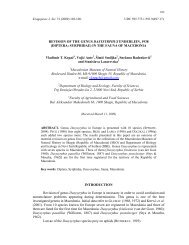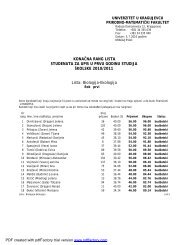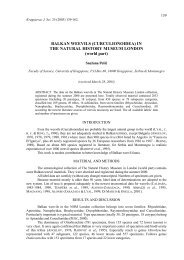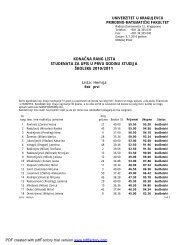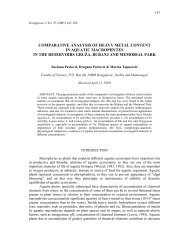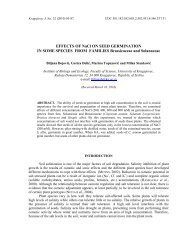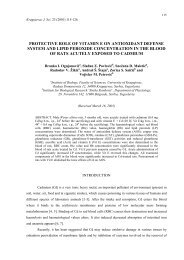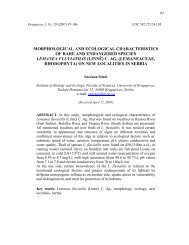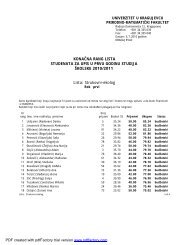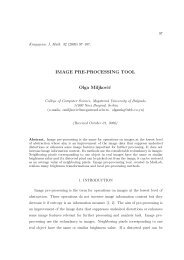Journal - Prirodno-matematiÄki fakultet u Kragujevcu
Journal - Prirodno-matematiÄki fakultet u Kragujevcu
Journal - Prirodno-matematiÄki fakultet u Kragujevcu
Create successful ePaper yourself
Turn your PDF publications into a flip-book with our unique Google optimized e-Paper software.
composition and succession of the phytoplankton community on the one hand and prevailingvalues of the indicated factors on the other. Biotic factors also exert significant influence onchanges in the phytoplankton community (Reynolds, 1984; Sommer, 1989; Olden, 2000).Characterized by the absence of a zone with dominant plants in the littoral, the BarjeReservoir consequently represents an unstructured habitat with a simple linear food chain:nutrients-phytoplankton-zooplankton-fish (Scharf, 1999). The effect of zooplankton on thephytoplankton community is very significant in determining the succession of phytoplankton(Sommer, 1989; Olden, 2000). The greatest visible influence stems from utilization ofphytoplankton as food by zooplankton, which directly results in reduction of the mass ofphytoplankton (Lambert et al., 1986; Sterner, 1989). The composition of zooplankton is also ofpotential influence (Bergquist et al., 1985). It is generally held that mesoplankters (for exampledaphnias of the group Cladocera) exert greater influence on phytoplankton biomass than dosmall species (Copepoda) (Hall et al., 1976; Lynch & Shapiro, 1981). Also, phytoplankton canmanifest a certain resistance to being consumed as food, which is a consequence ofmorphological differentiation in regard to cell size and shape, possession of hard shells, or thepresence of gelatinose coatings (De Bernard & Guissan, 1990).According to the data Kalafatić et al. (1997), zooplankton of the Barje Reservoir in 1996was characterized by low abundance (from 2 to 6821 ind/l). Protozoa, Rotatoria, Cladocera, andCopepoda were present. Maximal values were recorded in surface layers of water in the middleof the reservoir in May (2473 ind/l) and around the M of the Veternica River in September (6821ind/l). Minimal abundance of zooplanktonic organisms was recorded in layers of water next tothe bottom.The data of Simić et al. (2002) indicate that zooplankton during 1998/99 was characterizedby the presence of taxa of the groups mentioned, but also by significantly greater abundance(from 273 to 37000 ind/l). The lowest density of zooplankton occurred in the fall, while densitiesduring the spring and summer were considerably higher. During the autumn period, Copepodaand Rotatoria were the most abundant. Rotatoria were the most abundant in the late springperiod, while in summer large species of Copepoda and Cladocera were the most abundant, andRotatoria were dominant only in the shallowest part of the lake. The increased abundance ofzooplankton constituted a good trophic base for planktivorous species of fish and fish fry (Simićet al., 2002).According to the data of Simić et al. (2002), zooplankton in 2001 was not much changed inthe qualitative sense, but significantly altered in the quantitative sense. A general decrease inoverall density of zooplankton was evident in relation to 1998/99 (absolute abundance fluctuatedfrom 500 to 15,900 ind/l), but also significantly increased abundance of zooplanktonic formsfrom the group Cladocera, above all the eutrophic species Bosmina longirostris Müller duringthe summer period (August). Increase in the density of Cladocera--which have beencharacterized as mesoplankters and more capable feeders (Olden, 2000)--during this periodunquestionably affected decline in the density of edible groups of phytoplankton and madepossible dominance of the alga Anabaena sp. Cyanophyta are known to be relatively inedible(Olden, 2000). In keeping with increase in the density of larger forms of zooplankton during thisperiod, an increase was also evident in the desnsity of fish fry, primarily fry of Alburnusalburnus (Linnaeus 1758) (Simić et al., 2002), which resulted in decline of zooplankton density.61




